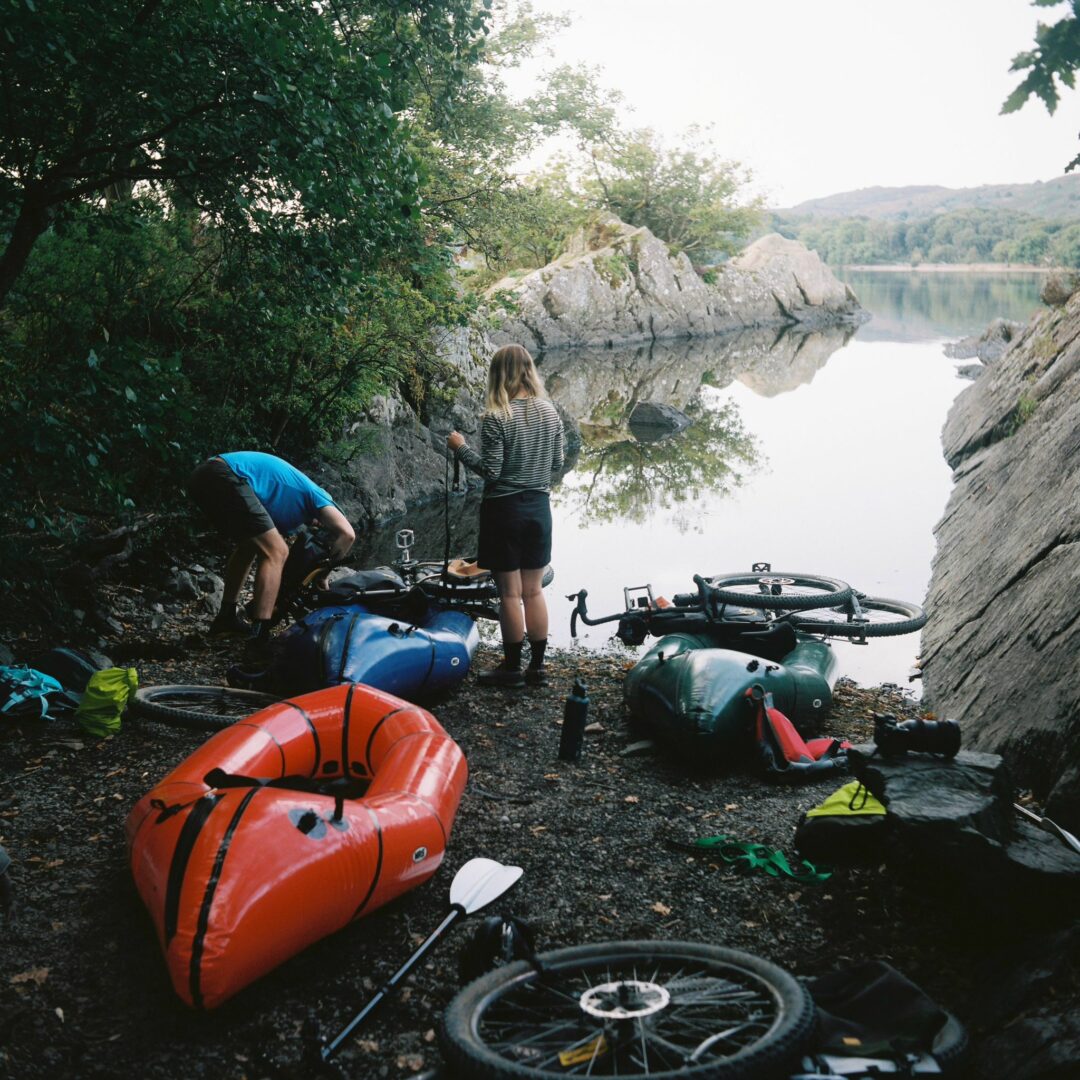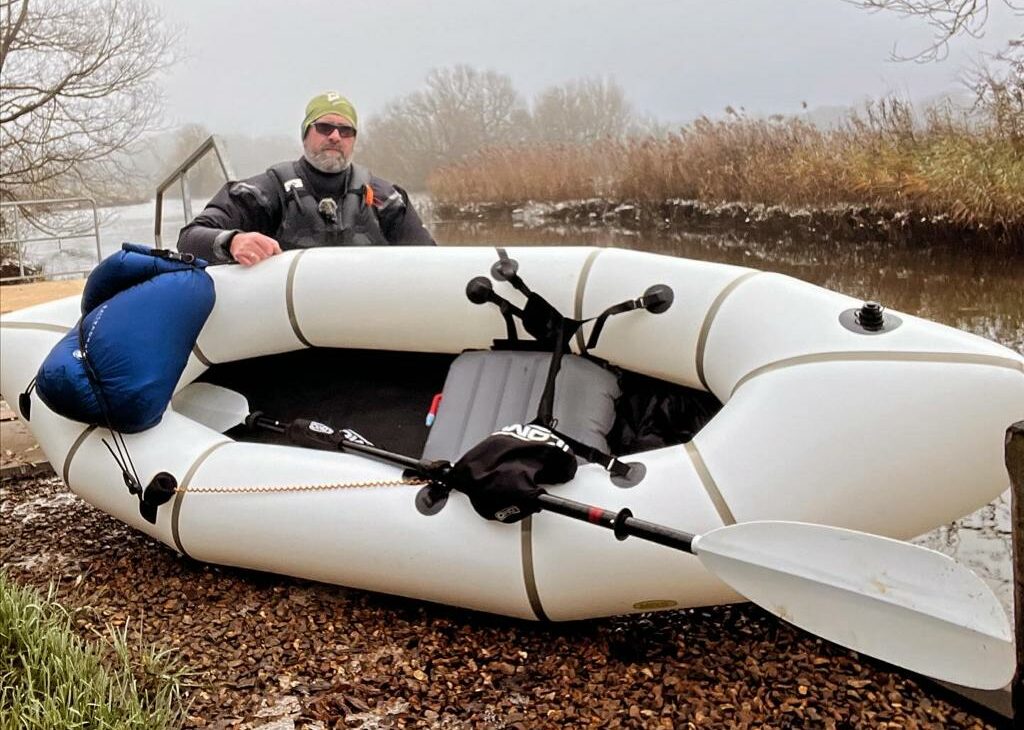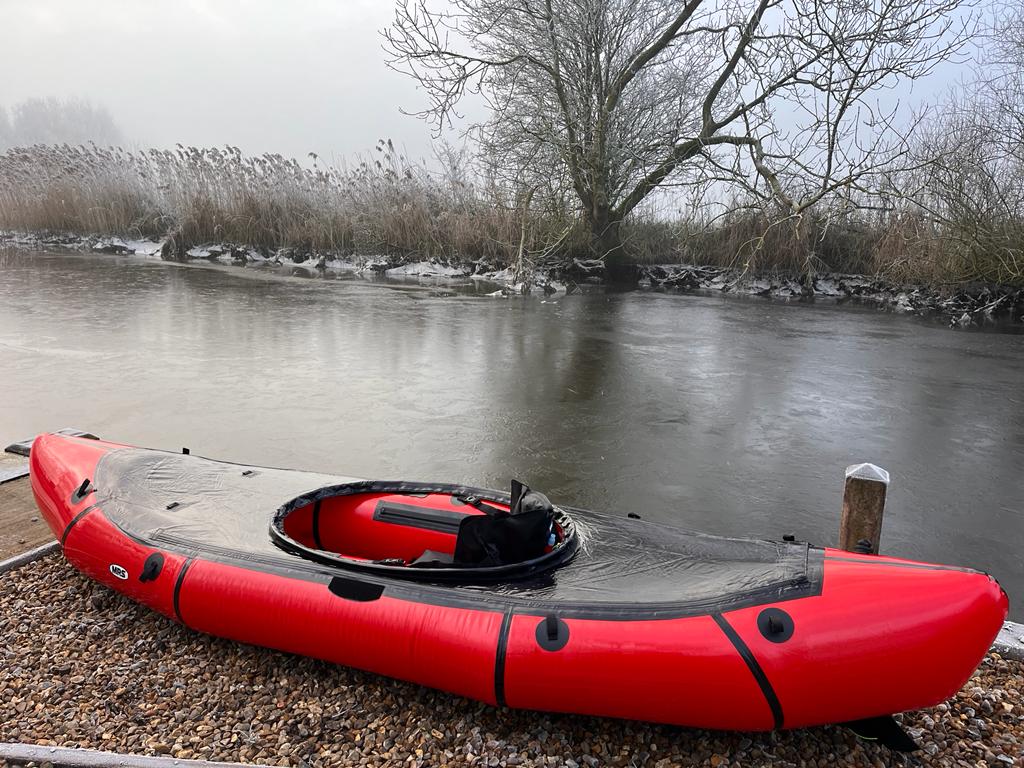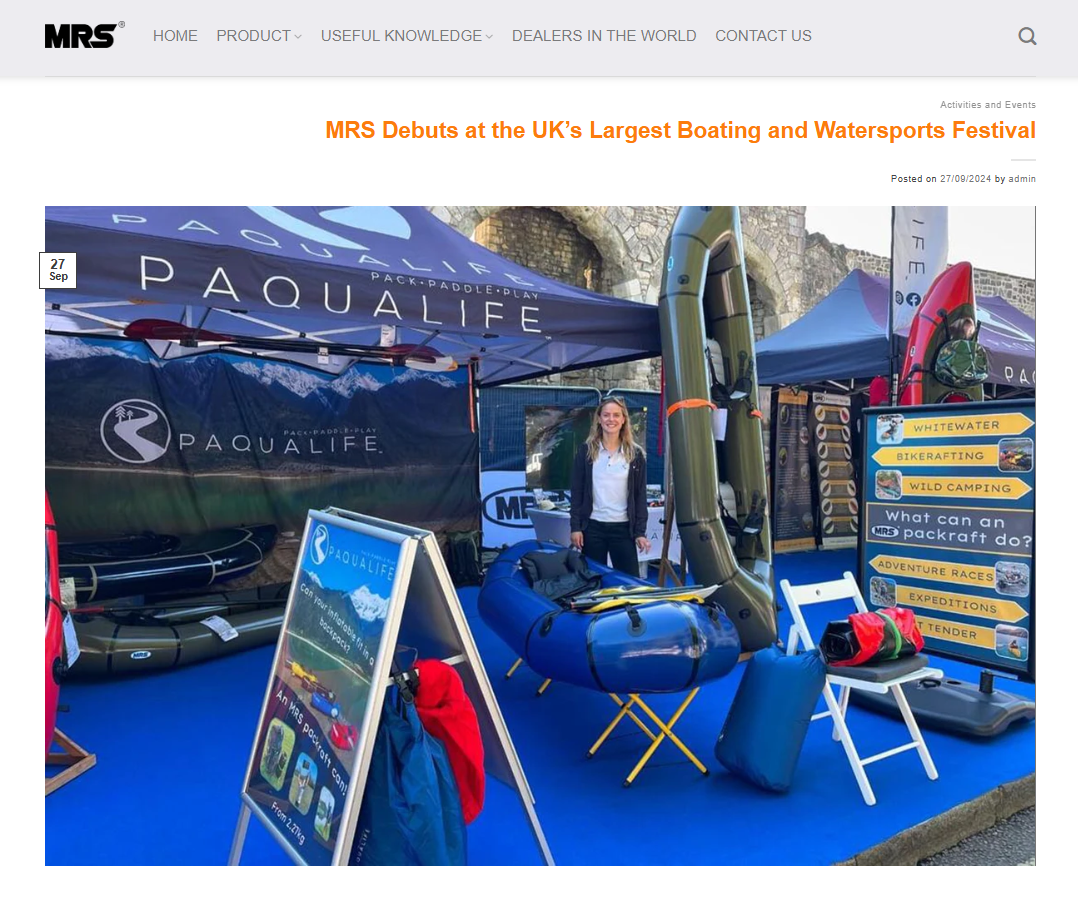What key things to think about?
It may sound strange, but you need to first think about what you intend to use your packraft for and what your priorities are?
Is weight the biggest priority above everything else, is robustness key for you for some harsh use down rapids, or is it a blend of both? Do you want speed to cover larger distances or just the ability to cross bodies of water or go down a river with ease and convenience? Do you need a spraydeck or is open top preferable to you? All these questions will help steer you to your perfect packraft! Packrafts are brilliant at all these things, but which one is best for you will depend on what your main uses will be.

The reality is, no one packraft does it all at the top of it’s game, but there are some pretty good all rounders which can get you going on your dream adventures until you are able to expand your packraft garage! Here are the top things to consider when choosing your perfect packraft:
1. Weight
There are a whole range of packrafts from the lightest 880g model, to the toughest largest tandem at 5.95kg.
The MRS packraft range is generally separated into three broad weight categories: The ultra light range, where low weight is the main factor above all else, the classic range, which suits most needs and the Pro range, which favours robustness usually reserved for those wanting to hurtle down rapids and want to know their packraft can survive the harshest of rides.
Let’s start with the lightest …
The MRS Nitrogen is super light, at only 880g it weighs nearly nothing and is so compact, you will barely notice it in your backpack side pocket. It packs super tiny and will give you the ability to cross bodies of water on the longest most challenging hikes! It is so small, it will almost fit in your jacket pocket! What’s the catch? The MRS Nitrogen isn’t the toughest – whilst it is made from robust ripstop 80D TPU, it isn’t a match for the rest of the MRS packraft range. It’s design is for light crossings where you and your gear needs to cross a river, or from shore to a nearby lake island to camp for the night, or to traverse down a gentle river to reach the other shore, or simply something to enable you to move in water on a long mountain hike or after a scramble/climb to hard to reach waters. For those uses where it won’t be constantly bashed against objects, it is perfect, robust enough, and the lightest in the MRS range!
There are more options in the ultra light range, like the MRS Minnow (1.86-2.12kg) and the MRS Surveyor (2.3-2.65kg). Both have 210D TPU tubes and floor which is tough enough for most users needs, but isn’t designed for whitewater as it isn’t as tough as other models in the range. However, at these weights, they are all perfect for long/expeditions where you want a capable packraft which weighs nearly nothing! The lightest version of each model are in white as the colour layup process for the polyurethane coating results in less weight than applying a colour … how cool is that!
MRS Surveyor (2.3kg in white)
Moving up the range, there are some super-light (but not ultra-light) models like the solo MRS Ponto and MRS Tulo, both with 210D TPU tubes and tough 420D TPU floors. These are intended for every day use, and are light enough to take on all-day hikes or multi-day expeditions where weight is not the only determinant (i.e. they are more robust than the ultra-light range). However, these two models are no heavyweights! The MRS Tulo only weighs 2.27kg and the MRS Ponto 2.95kg! Before the new ultra-light range was created, these two models were the lightest in the MRS packraft range.
Now into the classic mid-range. Models like the MRS Microraft, MRS Adventure X2 and the non-pro models of the MRS Alligator, MRS Barracuda R2 and the infamous MRS Nomad, are all really tough all rounders with an emphasis on different types of paddling (more on that later!). With the exception of the MRS Nomad S1, the rest of these models all boast a 210D TPU tube and 840D TPU floor (the MRS Nomad S1D also has a 840D TPU floor). They remain lightweight, but gain extra performance from a little extra thickness of material. For example, the MRS Microraft range weighs from 3.1-3.48kg, the MRS Adventure X2 (tandem) weighs only 4.4kg, the MRS Alligator (whitewater performance) weighs 3.23kg, the MRS Barracuda (fast tandem) weighs 5.1kg and the MRS Nomad S1 weighs 3.6kg.
Now for the range toppers, the best of the best for performance, but still very light in comparison to a mainstream PVC kayaks. The MRS Nomad S1D weighs in at 4.46kg (but gains an 840D TPU floor and spray deck), the MRS Alligator Pro at 3.75-4.3kg dependent on size, the MRS Viking at 4.4kg and the MRS Barracuda Pro at 5.95kg. The additional weight ensures a 840d TPU floor and 420D tubes (except the MRS Nomad S1D which retains 210d TPU tubes). This means these packrafts can handle some serious professional usage, but not at a huge weight penalty. Even the largest MRS Barracuda Pro is easily transportable on long hikes – simply check out the Adventure Racing sport in the Adventure Race World Series (www.arworldseries.com) where the MRS Barracuda Pro is by far the most frequently chosen packraft due to its weight, robustness and speed.
2. Speed
Generally you might want a faster packraft if you wish to cover longer distances, paddle all day or want to try some coastal paddling when conditions permit. In these situations, a packraft which is sleek, efficient to paddle and optimises paddler position will be the winner.
To understand what determines how fast a packraft is, you need to understand how design affects speed. Where you sit as a paddler creates a pivot when paddling. If you sit at the back you will notice when you pull a stroke of your paddle, you will change direction quite easily and quickly; this is ideal if you need to change direction quickly such as in whitewater where you need to change direction to avoid a rock or swing around instantly having been turned by a wave or prepare your approach before the next wave trough. Such ease in changing direction is not your friend when wanting each pull of your paddle to translate into forward motion rather than changing direction. This is the traditional packraft design, where you sit at the back and is an approach shared with much of the MRS range. We recognise however that many of our customers may want the “ability” to use their packraft on whitewater, but will most of the time want to make more gentle use of their packraft, where forward paddling efficiency is helpful. To assist this versatility, MRS supply their packrafts with a removable skeg which can be removed for whitewater, or fitted when forward efficiency is needed – there is also the option to purchase an extra large skeg (fits on the same mount) for even greater directional stability (i.e. more traction/less sway).
However, for some people, they are not interested in whitewater, and the greater need is to paddle efficiently with the ability to paddle longer distances. This is where models like the Ultralight MRS Surveyor, the MRS Nomad S1/D and the MRS Barracuda R2/Pro models come in. They all have symmetry from bow to stern (front to back) with a more slender shape, designed to cut through the water with greater efficiency, reducing drag as the packraft slides through the water. These models also focus on ensuring the weight of the paddler/s are centrally positioned to reduce sway and ensuring each stroke of the paddle translates into forward movement (i.e. rather than change of direction). This can make these packrafts less responsive to instant change of direction but allows them to paddle faster than any other design of packraft – these models are a unique innovation of the MRS packraft range. You will find these models have more comfortable backrests for long day paddles, and the MRS Nomad in particular has additional rod supports on the backrest, slotting into fixings on the tubes to ensure more of your body movement translates into paddling efficiency. Want to cover long distances more efficiently or fancy light coastal paddling? These models are for you!
3. Toughness/Durability
The durability of packrafts come from the material used. TPU (Thermoplastic Polyurethane) coated nylon is an extremely tough material, outperforming other competing materials such as PVC.
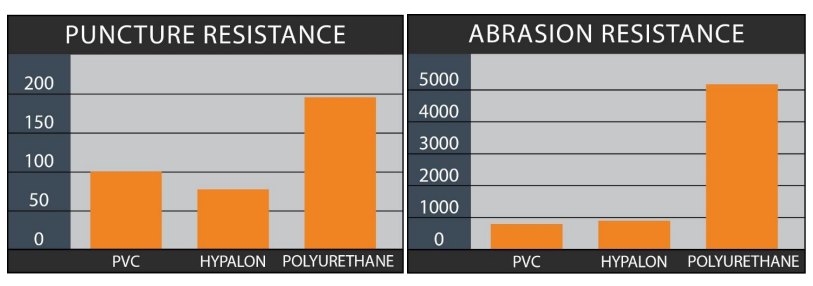
TPU is anti-bacterial and non-toxic, air-tight when sealed, has high tensile strength and is completely waterproof. It has exceptional weld strength, has excellent low temperature flexibility and general elasticity, its is environmentally friendly, has high resistance to abrasion and is UV resistant (so keeps it’s colour and doesn’t degrade in the sun!). This means that TPU has a much better strength to weight ratio than PVC and to get the same strength from PVC you must use a thicker material adding much more weight. It is no surprise that PVC kayaks weigh well in excess of 10kg for solo models and up to around 20kg for tandems! PVC kayaks also tend to use harmful glues, which are not only not environmentally friendly, but also are prone to fail – unlike TPU constructed MRS packrafts that are stitched and heat welded to provide a permanent seal.
You only need to do a google search for “TPU vs PVC” to see how superior TPU is to PVC. The trade off? Well, there are always trade offs, and TPU due to it’s superiority over other materials is a much more costly than PVC. MRS packrafts do not however compromise on quality and only choose TPU. Another factor for materials is that not all TPU is made the same! There are higher quality and lower quality examples, and MRS are meticulous in selecting only the best TPU. See the Guide on MRS quality in the Adventure Library for more.
So now you know more about TPU and it’s superiority to PVC. What about the choices of TPU in the MRS packraft range?
There are four main TPU choices across the range:
- 840D (double sided, reserved for floors) which is phenomenally tough but not the lightest
- 420D (single sided) used for some Pro model tubes and a number of MRS packraft floors (in which case it is double sided TPU)
- 210D (single sided) used for the majority of MRS packraft tubes and some ultra-light packraft floors (in which case double sided)
- 80D TPU for the lightest model, the MRS Nitrogen.
The number referenced relates to the weight/denier of nylon fibres underneath the polyurethane coating, in grammes per 9000 metres of the material ie. 210D TPU would be 210 grammes of nylon in each 9000 metres of the material. The higher the number (e.g. 420D and 840D) means there is more weight, and therefore nylon material, beneath the polyurethane. The higher the number, the tougher the TPU, but greater the weight. Whether TPU is single coated (i.e. polyurethane on one side or both) does not translate to strength, but having polyurethane coating can protect damage/wear on the nylon fibres. It is for this reason that in high-wear exposed surfaces, such as a packraft floor, MRS put polyurethane coating on both sides (double sided TPU), but not on the inside of the tubes. Whilst MRS packrafts with a TiZIP (airtight/watertight zip to allow storage of gear in the tubes) allow gear to be inside the tubes, those areas are still not high-wear, especially when gear is stored correctly in storage bags (supplied with each packraft with a TiZIP) – and so the benefit of polyurethane coating on the inside of packraft tubes doesn’t justify the additional weight and pack size that would result in.
So in simple terms, if you want a tough packraft, go for a higher denier TPU. 840D TPU floors are super tough and cover most of the MRS packraft range, giving you confidence in all paddling environments. 420D TPU tubes would be tough enough for harsh whitewater usage and is sufficient for packraft floors for most uses. Even 210D TPU, which is used for most MRS packraft tubes (except the Pro models which use 420D), would be more than tough enough for 90%+ of users. Paddlers must be aware however to avoid sharp objects where possible, and the 80D TPU MRS Nitrogen is for gentle usage only.
Have a look at the denier TPU on each packraft to see if it suits you. Typically a 840D TPU or 420D TPU floor and 210D TPU tubes is the best middle-ground combination for most paddlers, but there are lighter models with lower denier TPU and heaver denier TPU models depending on how you will use your packraft and what is important to you.
4. Agility
Do you need a packraft which you can change direction quickly? This is often reserved for whitewater users, or those predominantly paddling down rivers. The best way to think about it is that where you sit on a packraft is where you pivot and it will influence how easy it is to change direction. If you have a shorter packraft where you sit further back, you will pivot from the back where your weight is, this means the change in direction at the front of the packraft will be more severe, with each stroke of your paddle the front will move left or right with ease. This is useful in whitewater where you may need to change direction very quickly to avoid obstacles or change direction instantly, but it is not so useful for paddling efficiently on longer paddles where you want each stroke of the paddle to convert into forward motion rather than sideways movement. These “whitewater” packrafts have removable skegs, which when fitted help improve tracking and forward movement, reducing the left or right “sway” as you paddle. With consistent regular paddling movements, these packrafts can still track well, but for whitewater, remove the skeg and enjoy extreme manouvreability! Models with this design include the majority of the MRS range, including the MRS Tulo, MRS Ponto, MRS Microraft, MRS Alligator and MRS Viking series. The MRS Alligator and MRS Viking models are particularly agile though, designed specifically for whitewater, whereas the MRS Tulo, MRS Ponto and MRS Microraft are designed as more “do it all” packrafts, suitable for both rivers and touring.
For packrafts used to cover longer distances as the “main” use, a different design is used by MRS. This involves a narrower, sleeker design to cause less resistance when pushing through the water (so is faster as a result), and it also requires a more central seat position. This reduces the “sway” when paddling, and left/right movement will be significantly reduced with each stroke of the paddle, resulting in more of the energy from each paddle stroke converting into forward movement. This results in a packraft which tracks better and faster than the ‘traditional’ packraft design where you sit at the back. So, if you are wanting to cover longer distances or are used to paddling a hard touring kayak, something like the MRS Nomad or MRS Barracuda R2 packrafts would suit best; even the ultra lightweight MRS Surveyor and MRS Surveyor X2 models would work well if weight is a key factor for you.
See the below diagram which visually compares a pure whitewater packraft, the MRS Alligator 2S, with a touring specialist, the MRS Nomad S1. You will notice the different pivot points with the MRS Alligator 2S seating position noticeably further back when compared to the MRS Nomad S1. You can see this, compared with the slimmer shape of the MRS Nomad S1, results in very different movements at the front of the packraft.
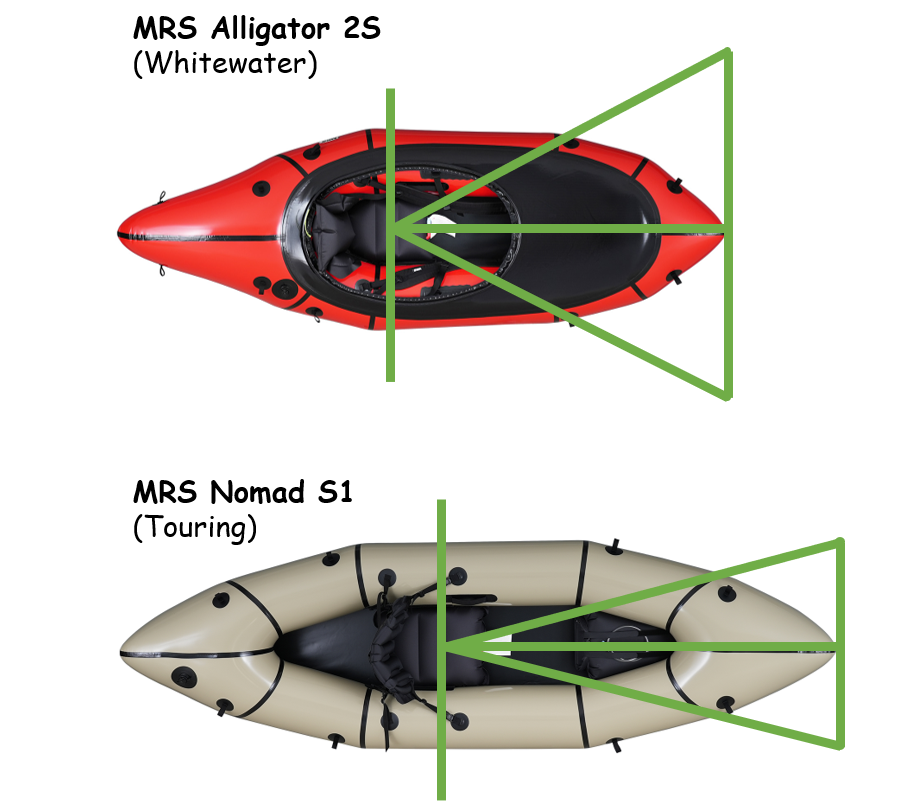
5. Carrying loads (bikerafting/expedition)
Do you need to carry lots of gear, possibly a bike? Packrafts are brilliant at this! Check out the below photo of a custom coloured MRS Microraft L (3.48kg) carrying a fat bike – the customer then switched it up and carried the packraft on the handlebars of the bike! Read more here: Bikerafting with your MRS
There is a huge amount of buoyancy in a packraft thanks to the large tubes which also sit directly on the water, making them extremely stable – perfect for carrying gear. The key for carrying loads such as a bike, is a stable platform upon which to attach the load, Models such as the Microraft (now slightly wider to make carrying bikes even easier!) are ideal because not only do they have a stable platform to attach a bike (or other gear), they also retain a traditional shape to the bow (the front) which helps maintain efficiency in the way the packraft moves through the water. By contrast, a squared-off bow is less efficient through the water, slower and actually causes more resistance – not helpful for either speed or balance! Those other craft with squared bows also tend to have their bows raised high – this causes another problem. If the weight of your load (such as a bike) is further away from the water, it raises your “vertical pivot” and can leave you prone to more problems with balance than if your weight is closer to the water.
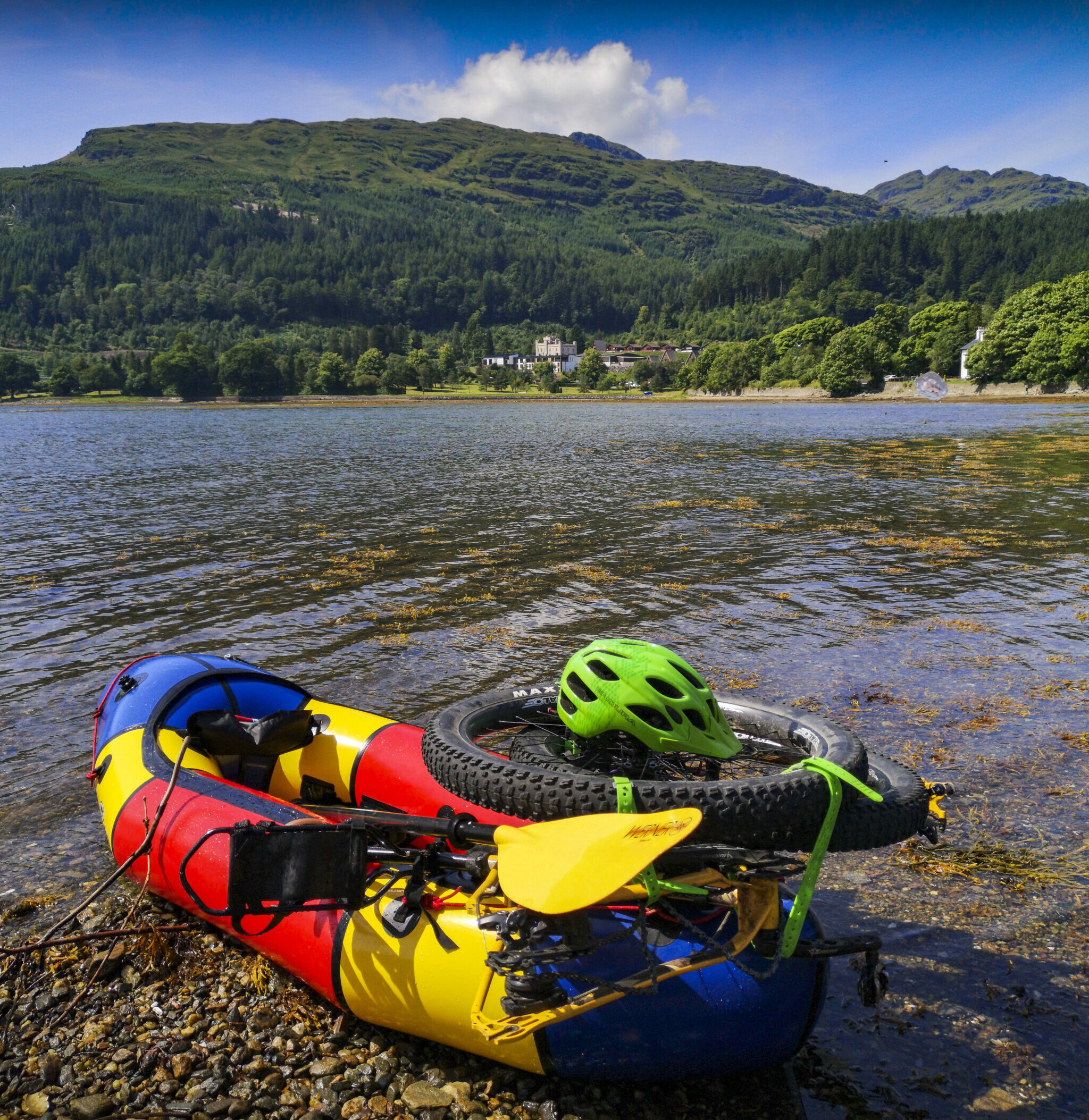
Most of the MRS range are “capable” of carrying a bike, with the exception of the ultra light range. The best models for carrying loads of gear would be the MRS Ponto (a great stable, simple, no-nonsense packraft), the MRS Microraft L (a fantastic all rounder with a great bikerafting reputation), the Microraft XL (like the Microraft L but with more room), and for tandems, the MRS Barracuda R2.
But that’s not to say that you cannot get creative. If you have a small bike and are a smaller paddler, there is no reason why the MRS Tulo cannot carry a bike too! Check out the below image of an MRS Tulo, fully loaded. Like in all instances where you load a packraft, the key is to balance what you carry, it’s weight and bulk, with the size packraft you have and to ensure it is evenly distributed, considering paddler weight and position as well.
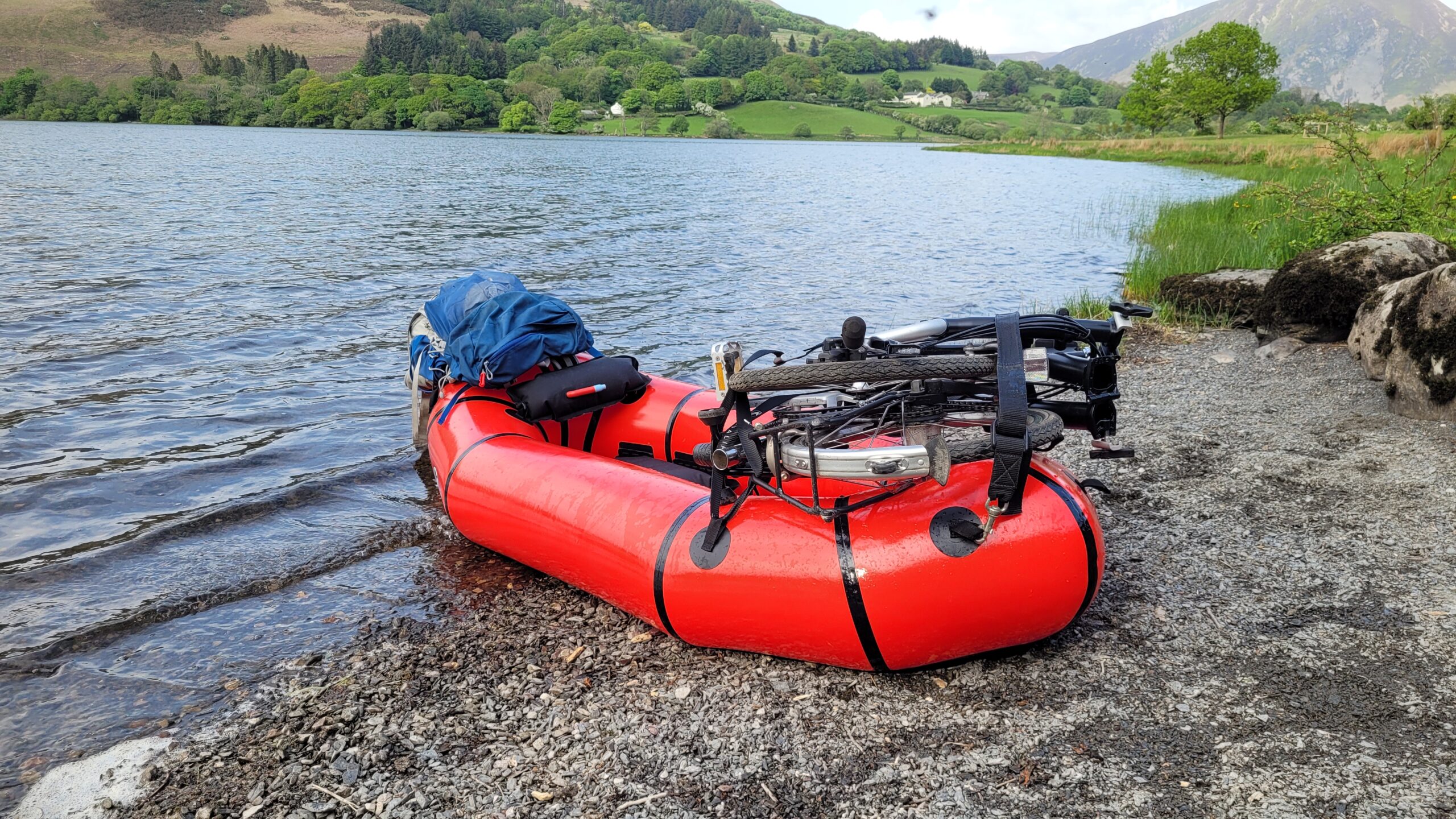
So what about other storage? Well, many MRS packrafts have the option of internal storage. A TiZIP waterproof, airtight zip (similar to high tech dry suits) is heat welded into the tube of the packraft, allowing you to store your gear inside your packraft. Check out more here: TiZIP Maintenance
This means you can take a huge amount of gear with you and store it in your packraft tube, out of the way. This has a number of advantages. First it means you can take lots of gear with you on your hike or expedition and when paddling, you don’t need it cluttering the space inside or on the packraft – you can store lots of appropriate gear (i.e. not sharp objects unless packaged) such as a tent, sleeping bag, air mat, spare clothes etc. Second, it helps lower your centre of gravity which improves balance when compared to loading your gear higher up on the bow of your packraft.
Below is the MRS Ponto showing the TiZIP at the stern (the back) and all the gear that went into the packraft…
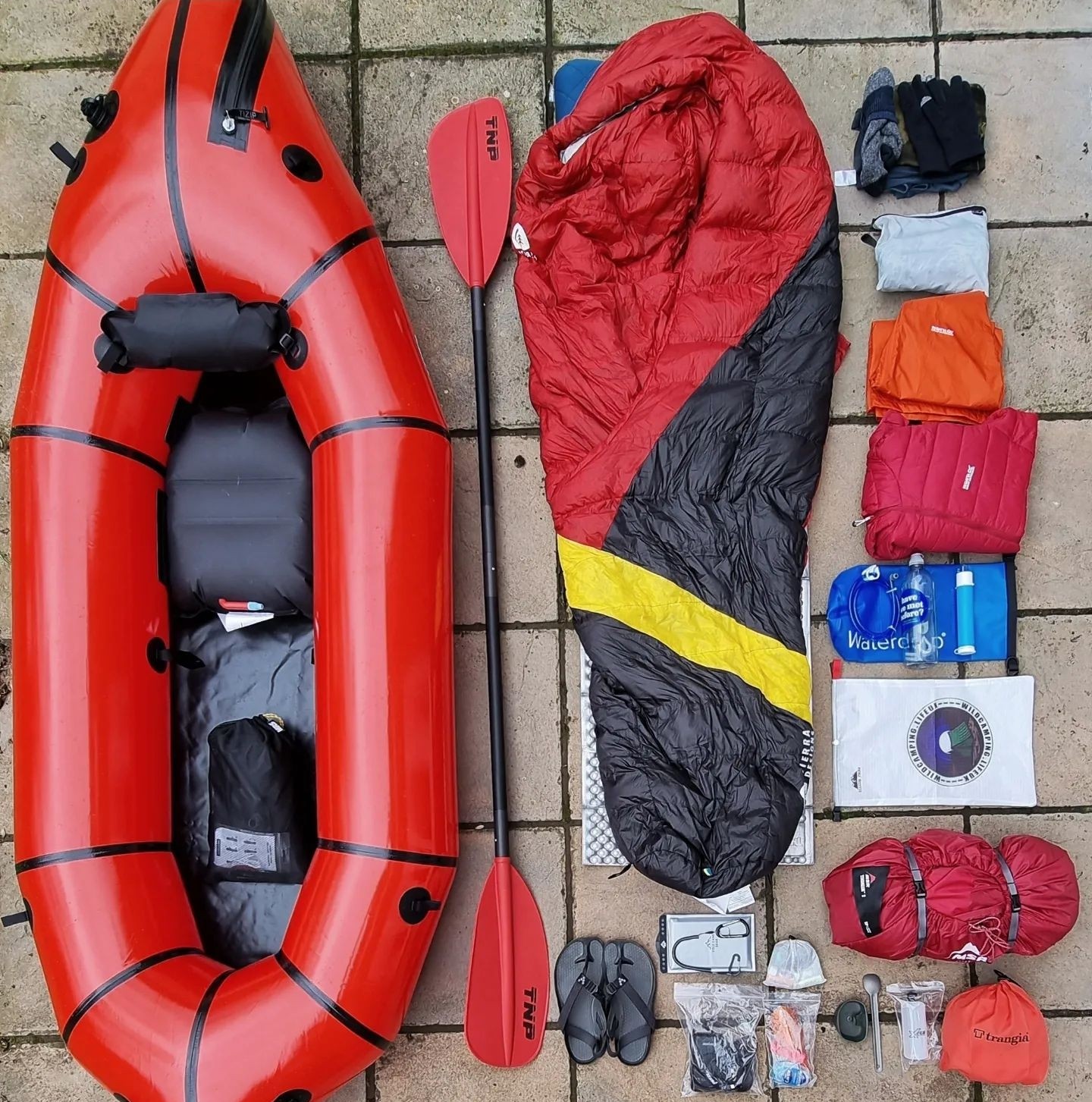
Below is a photo of the nylon dry tube bags being inserted into the TiZIP with gear inside! How amazing is that! If you are willing to commit to the maintenance of the TiZIP, it is an incredible piece of kit which will transform your adventures. To read more on TiZIP maintenance please click here: TiZIP Maintenance
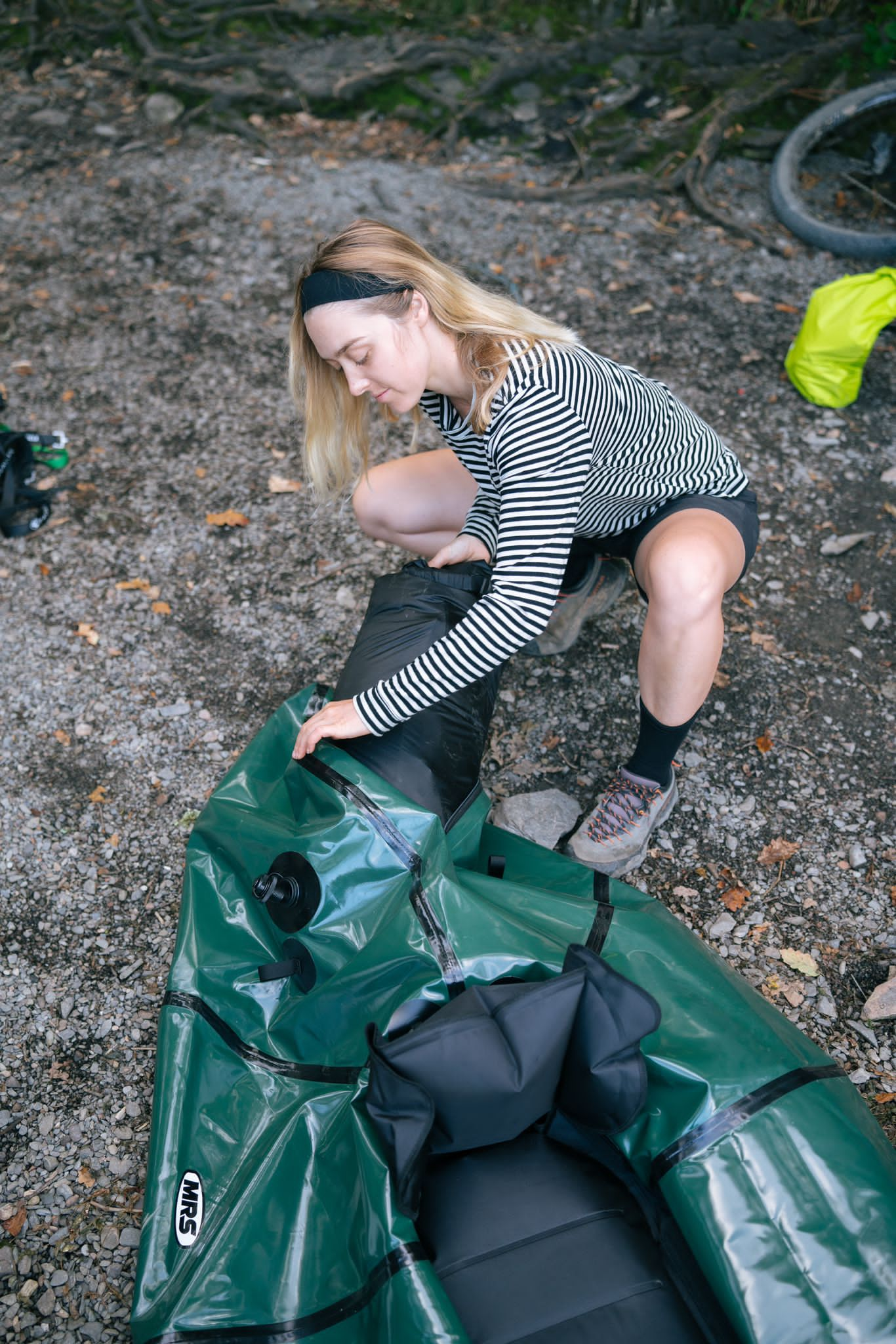
All MRS packrafts can be fitted with the TiZIP at the point of manufacture, except the following models: MRS Nitrogen, MRS Minnow and MRS Tulo.
6. Ease of Maintenance
As discussed in the previous section, TiZIP internal tube storage is a fantastic piece of kit that will transform your adventures, but it does come with the need for additional maintenance: TiZIP Maintenance. Maintaining your TiZIP will help you have years of trouble free service from one of the most versatile, ground breaking and amazing innovations available for water craft today – a unique option for packrafts. However, if a TiZIP is not maintained properly, they can suffer from hydrolysis, a chemical reaction that can occur when the TiZIP material is left in contact with water for long periods of time, for example if stored for long periods in damp conditions. The result will eventually be a number of pinhole air leaks in your TiZIP. To avoid this, it is important that when you have a TiZIP, you thoroughly dry your packraft and the TiZIP before placing it in storage and ensuring where you store it is clean and dry (not damp!). It is also important that you keep your TiZIP clear of grit and dirt, and regularly top up with a small amount of the special grease provided with your TiZIP (more available in the Paqualife shop).
Keeping your packraft clean and dry is also good practice for any packraft and allows the material to relax by not storing it for long periods in a tightly rolled shape. Simply clean with soapy water after your trip or expedition, dry it with a clean cloth (microfibre is perfect), then fold loosely for storage. Also, ensure your inflation valve is clear of dirt before storage, ready for it’s next use.
Packrafts are super easy to maintain and, because of heat welded seams, are not prone to failure along the seams unlike cheap PVC inflatables that use environmentally harmful glues.
If you want the easiest to maintain packraft, select one without a TiZIP internal storage zip; if you are happy with the simple maintenance of the TiZIP and want the extra versatility of being able to store your gear inside the tubes, then opt for a model with a TiZIP.
7. All year performance
An MRS packraft is suitable for all year use. However, some models will make use in the winter months more attractive – and let’s be honest, if going for a paddle is attractive and easy, you will do it, but if if it is likely to be cold, wet and miserable, you are unlikely to go out in the winter.
So which packrafts give you that extra shelter in the winter? The answer is one with a spraydeck, and there are a variety of spraydeck options available with different MRS packraft models. See here for more: Which spraydeck is right for me?
A great all-rounder which has an easy to remove spraydeck is the MRS Microraft; it has a retractable spraydeck which is designed to keep paddle drips and light splash off your legs (but won’t keep all water out if you go down whitewater). It is easy to remove thanks to a velcro strip down one side and zip down the other which then can be rolled back and secured. The other benefit is that the spraydeck will keep cooler wind off the lower part of your body if paddling when it’s a bit colder.
Other models with spraydecks include the ultra lightweight MRS Surveyor (a light spraydeck mainly to keep paddle drips off and provide some cold air shelter), the MRS Adventure X2 tandem, MRS Barracuda R2 Pro tandem and whitewater specific MRS Alligator with it’s fully sealed spray deck.
Our recommendation – if you want the most versatile all-season packraft, you can’t go wrong with either the MRS Microraft or the MRS Nomad S1D, shown below.
MRS Microraft L
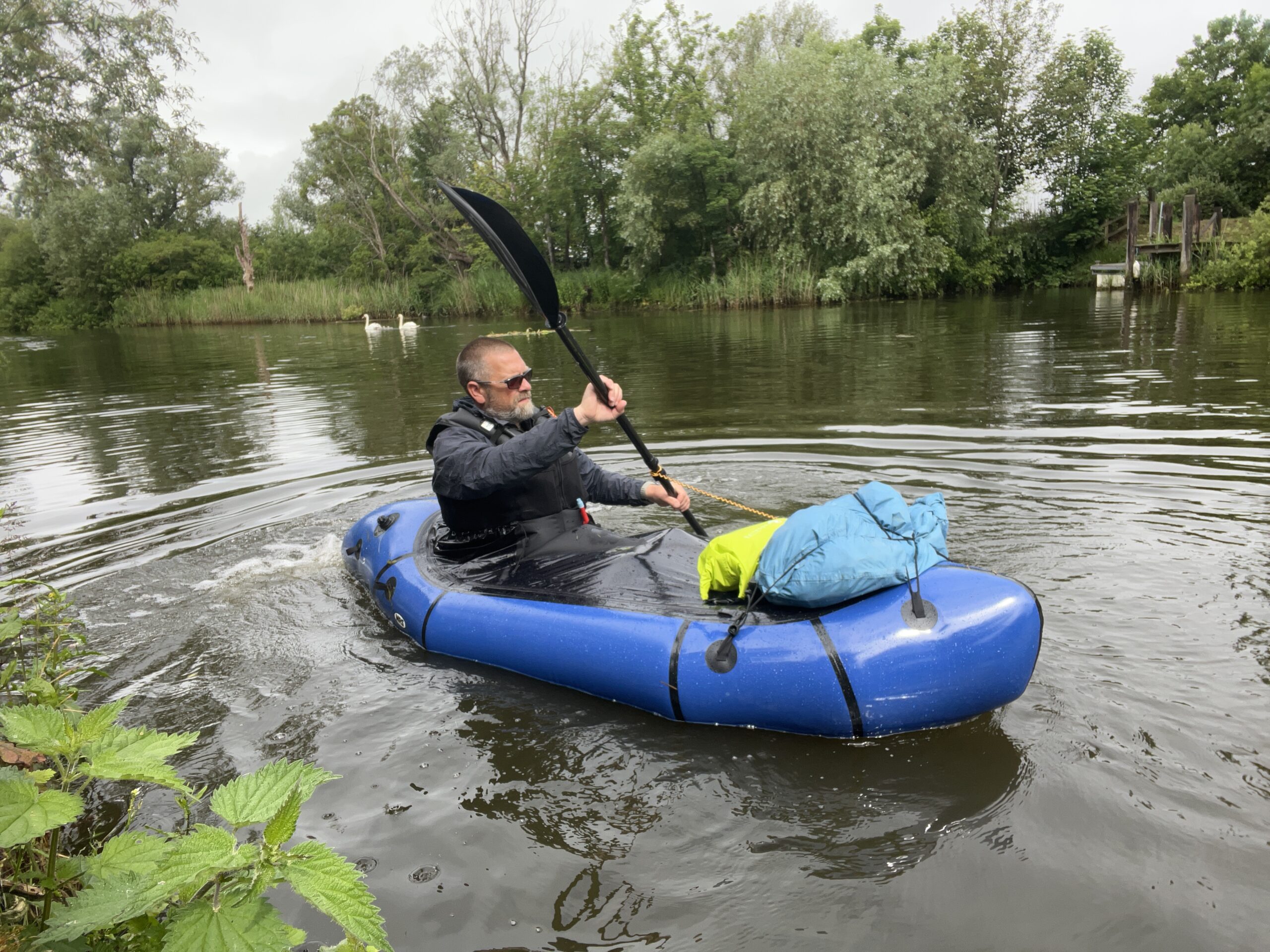
MRS Nomad S1D
8. Pack size
Do you need the smallest packraft to fit in or on a backpack? Perhaps you are going on a multi-day expedition or simply don’t have much space or weight left when going on holiday.
If you need the smallest packraft for a short, easy crossing, perhaps to a remote lake island to camp or to cross a slow moving river or lake section, look no further than the 880g MRS Nitrogen. A seat is optional, it does not have a removable skeg and no backrest is supplied. This model is simply to make those easy crossings and is not designed for long paddling routes or rough water. But, if the smallest craft is what you need, then this is it and it will fit into the side pocket of most backpacks, maybe even into some pockets!
MRS Barracuda R2 (left) and MRS Ponto (right) next to a 40L backpack
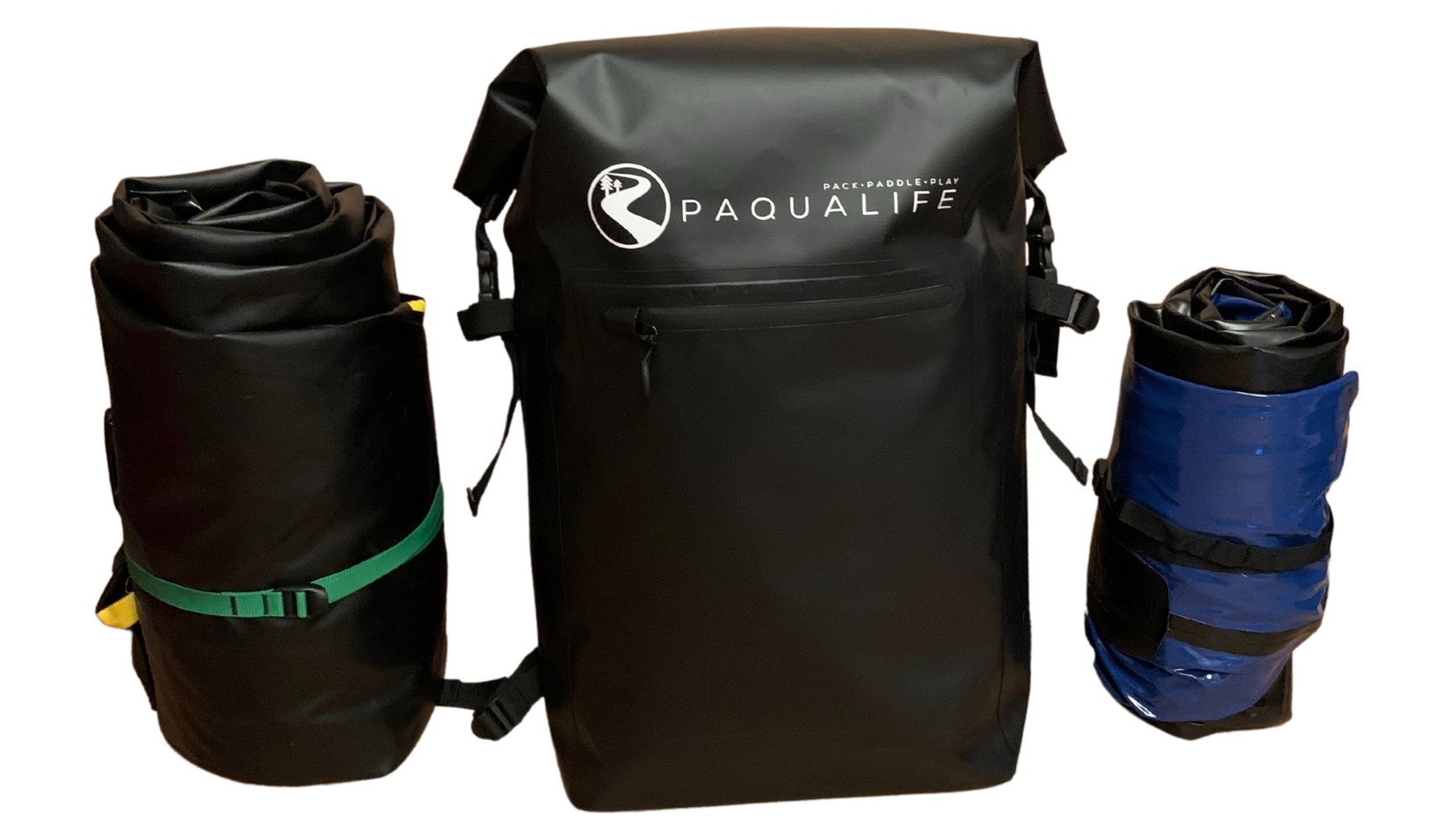
For more capability but maintaining ultra light weight, the MRS Minnow is also very small when packed and weighhs from 1.86kg (white) to 2.12kg (olive). It rolls super small to fit in a small backpack and you will barely notice carrying it on a long hike or climb. It is roomy enough and has a good weight capacity. Thanks to a lightweight seat and backrest it is both lightweight and comfortable. The MRS Surveyor and the Surveyor X2 are even more of a step up in capability; perfect for longer paddles, they are efficient and fast, with a generous weight capacity – at only 2.3kg for the white model and 2.65kg for the olive version they are super light. These will also fit into a very small backpack and you will barely notice it on a long hike; they aren’t however as durable as other models.
Going up the range in terms of pack size, the MRS Tulo weighs 2.27kg but will pack up super small, whilst the MRS Ponto and MRS Microraft also roll up small enough to fit into a 25l backpack with space to spare. The MRS Nomad will fit into a 25-30L backpack, whilst the larger tandem models like the MRS Barracuda R2 will fit into a 40L backpack with ease.
Below is the MRS Microraft L (3.48kg) rolled and attached to the handlebars of a bike.
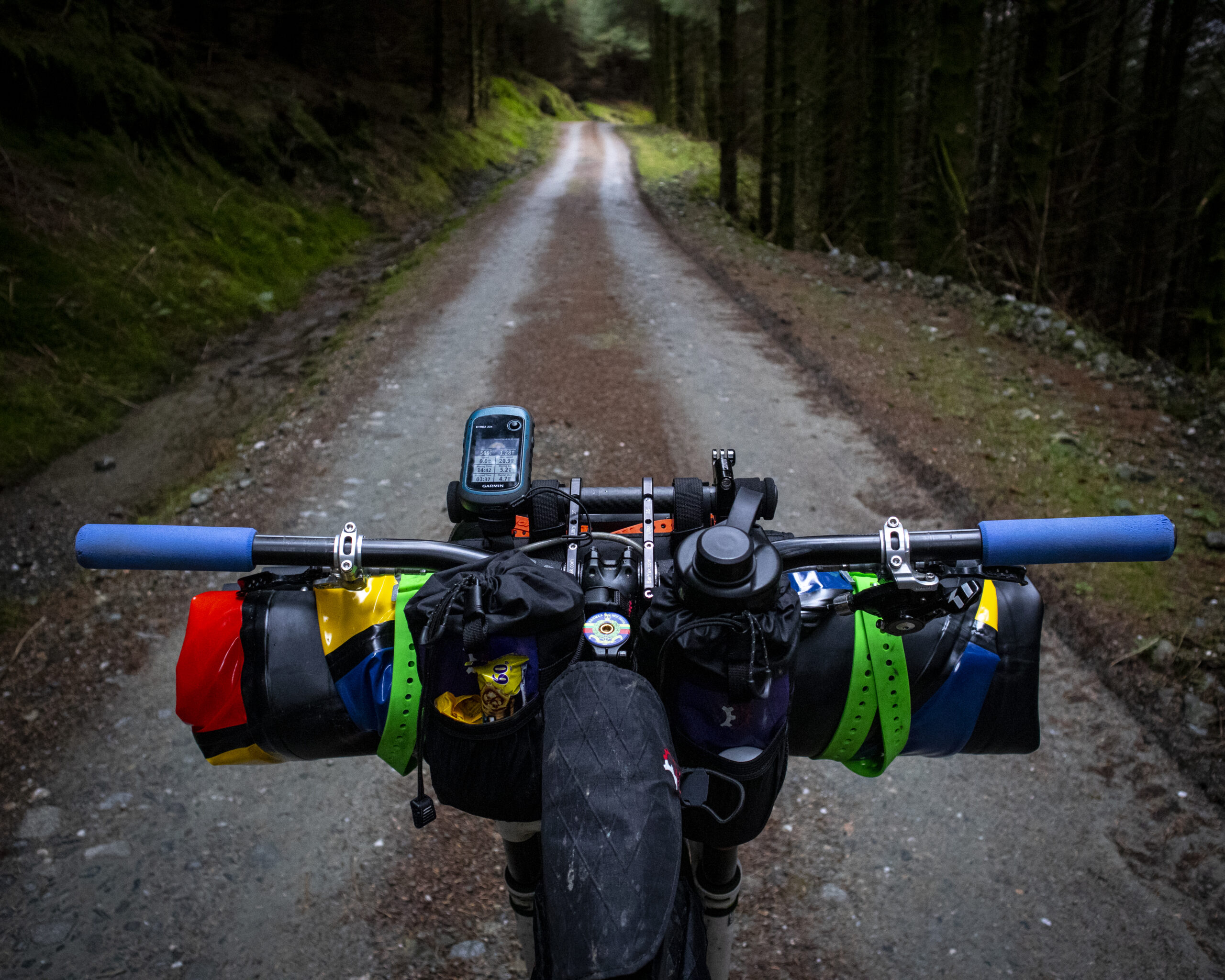
So, whichever MRS packraft you choose, they are all extremely portable – the question is how portable and small do you need it to be, and are you willing to trade pack size with robustness? If compact is what you want above all else, the ultra light range packrafts are hard to beat. Likewise, the more robust models, such as the MRS Microraft, MRS Nomad and even larger MRS Barracuda R2 are still small enough to pack for an all day hike. Check out the Adventure Racing World Series Adventure Racing World Series | Home of Adventure – ARWS (arworldseries.com) where competitor teams carry MRS Barracuda R2 packrafts on speed hikes as part of timed races.
Adventure Racing teams using the MRS Barracuda R2
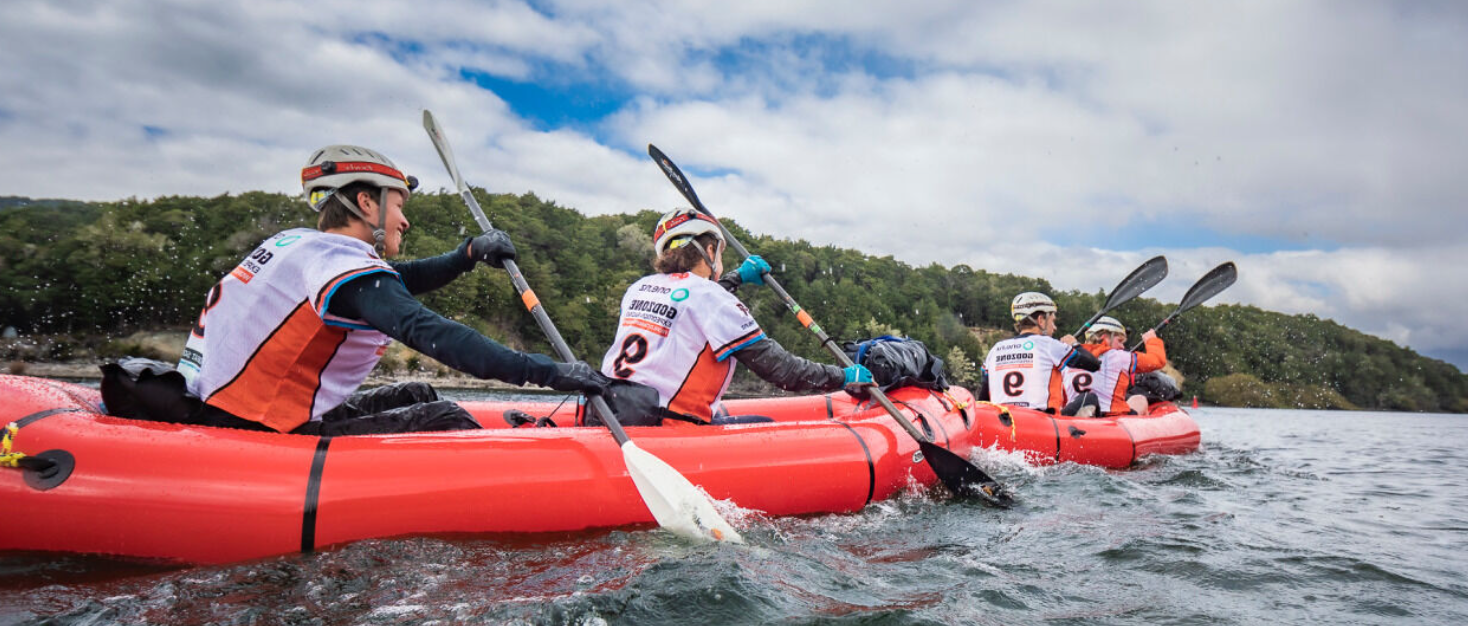
9. Paddling solo or with a companion?
Tandem, solo or maybe both?
The MRS packraft range has a large number of options, which can be confusing. However, the question of solo or tandem is usually more straight forward. You want a solo packraft, go for one of the solo models based on your individual needs. You want a tandem that is fast, comfortable and roomy, the MRS Barracuda R2 is unbeatable.
Some customers want a tandem but wish to still keep the weight down. For this, the MRS Surveyor X2 is perfect. It isn’t as robust as the MRS Barracuda R2, having a 210D TPU coated floor, compared to the MRS Barracuda R2’s 840D TPU coated floor. If you aren’t planning to go down whitewater and generally paddle in waters where you aren’t bashing against the shore, the MRS Surveyor X2 is ideal. Don’t think the 210D TPU floor is weak though, it is still tough enough for you to beach your packraft without concern.
For a compact tandem, the MRS Adventure X2 is an option but will feel compact for two large adults, with a more upright seating position and knees more bent. It is however good for those shorter paddles where two adults need to be carried with gear and don’t require as much speed.
What about a packraft that can be paddled solo as well as tandem? – The MRS Microraft XL and the MRS Barracuda R2.
The MRS Microraft XL is mainly a solo packraft for larger/taller paddlers or where there is a need to carry allot of gear. If you are a smaller/average height paddler, the MRS Microraft XL can feel a bit too roomy, but is suitable with an inflatable footrest available from the Paqualife shop. Without gear on the bow (front) a lighter/average height paddler, may find the front is too light and benefits from carrying gear, like a bike, to keep the packraft more level and assist with tracking. If you are average height though and need to carry heavier gear on the bow (front), then the MRS Microraft XL is ideal. The versatility in the MRS Microraft XL is provided by it’s extra length, allowing room for an inflatable cushion to be inserted into the front to provide a seat for a non-paddling passenger or child. So for families with children, it is ideal.
The other innovative option is the MRS Barracuda R2 (and Pro model) which are true hybrids. They have two seat configurations, one facing one way with two seats and backrest, then in the second seat configuration facing the other way, a central seat position for a solo paddler. There is a skeg mount on each end of the packraft to allow the skeg to be positioned to face the direction matching the chosen seat configuration. The MRS Barracuda R2 is mainly a tandem and the best on the market, but if you wanted to occasionally paddle solo, it is highly capable and would be extremely roomy! If you paddle solo most of the time however, you would find the models designed specifically as solo packrafts easier to paddle.
MRS Adventure X2 (red)
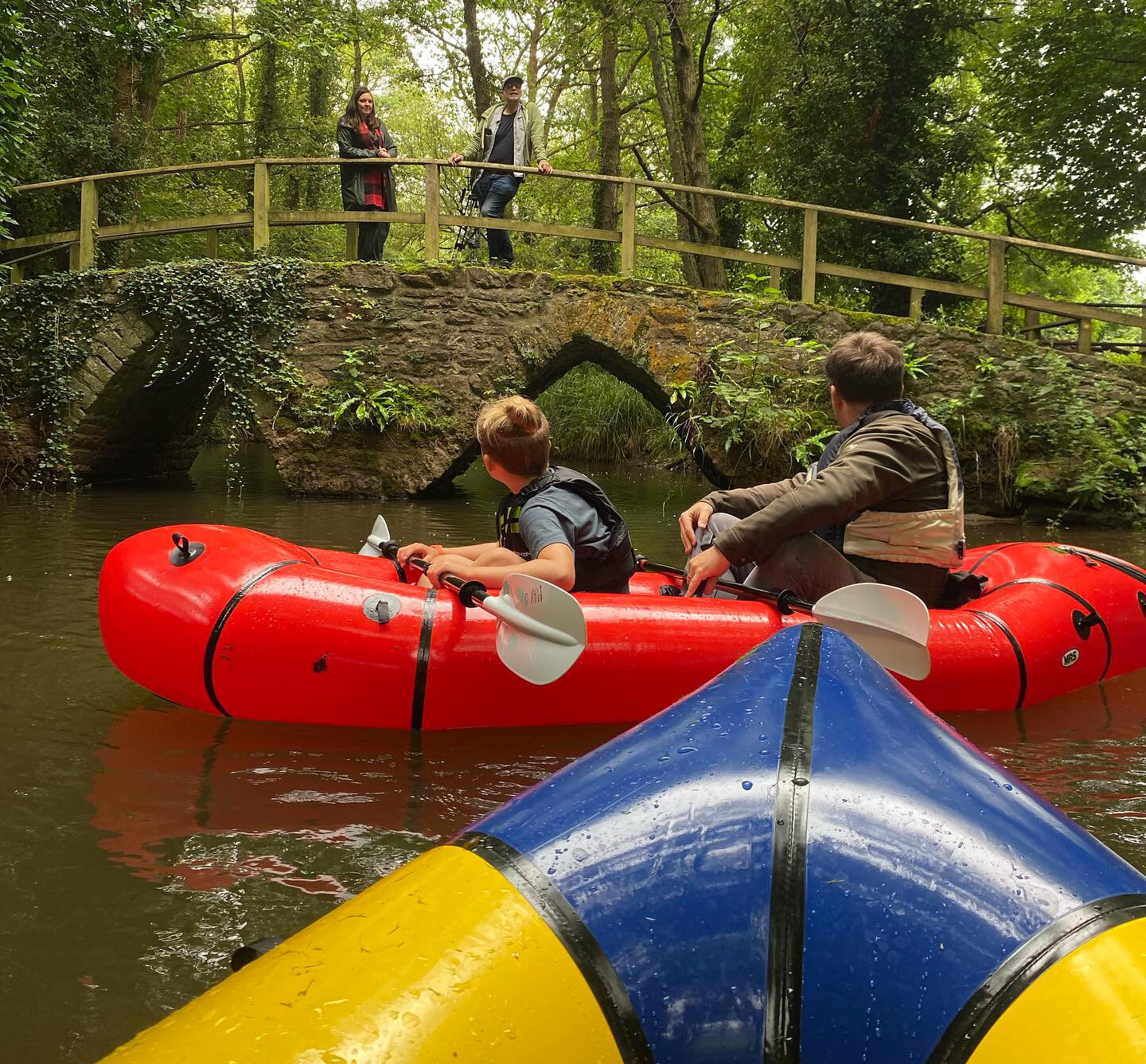
MRS Barracuda R2 (Green)
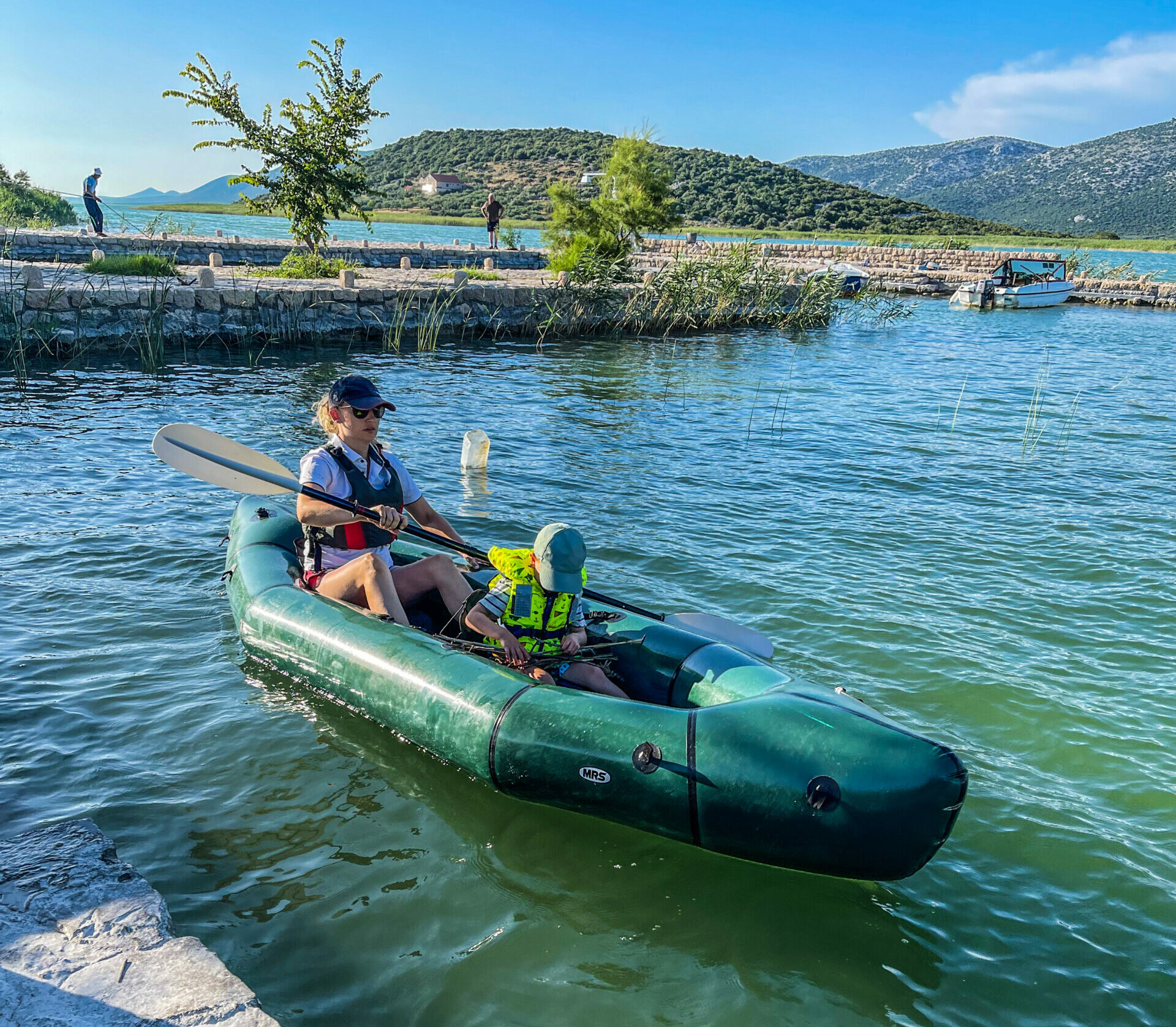
10. The all-rounder
You have decided you want a packraft but want it to do many things and be suitable for a number of different trips. Is there an all-rounder?
Which packraft is best for you will depend on how you plan to use it, and we would be happy to advise you on your specific needs towards the best suiting packraft.
However, the “best” all-rounder in our opinion in the MRS Microraft L. It is very light at 3.48kg and rolls amazingly small, enough to fit into a 25L backpack with ease. It is also suitable for some light whitewater (Grades 1-3 dependent on paddler experience), touring longer distances (though not as fast paddling as the MRS Nomad, MRS Surveyor, MRS Barracuda R2 or MRS Surveyor X2), and can carry a bike with ease. It is confidence growing due to it’s stability, and can have the optional internal storage system via a TiZIP. Even better, it has a removable spray deck which makes it suitable for year round use, keeping cooler wind away from your legs and paddle drips away; but if you want it open in the summer, the spray deck is retractable. The MRS Microraft is also great for taking your dog with you on your adventures and with a tough 840d TPU floor is super tough for the hardest adventures.
So our recommendation if you want a packraft that does a bit of everything – the MRS Microraft L is a very solid choice.
MRS Microraft L (3.48kg) with spraydeck rolled forward and dog on board
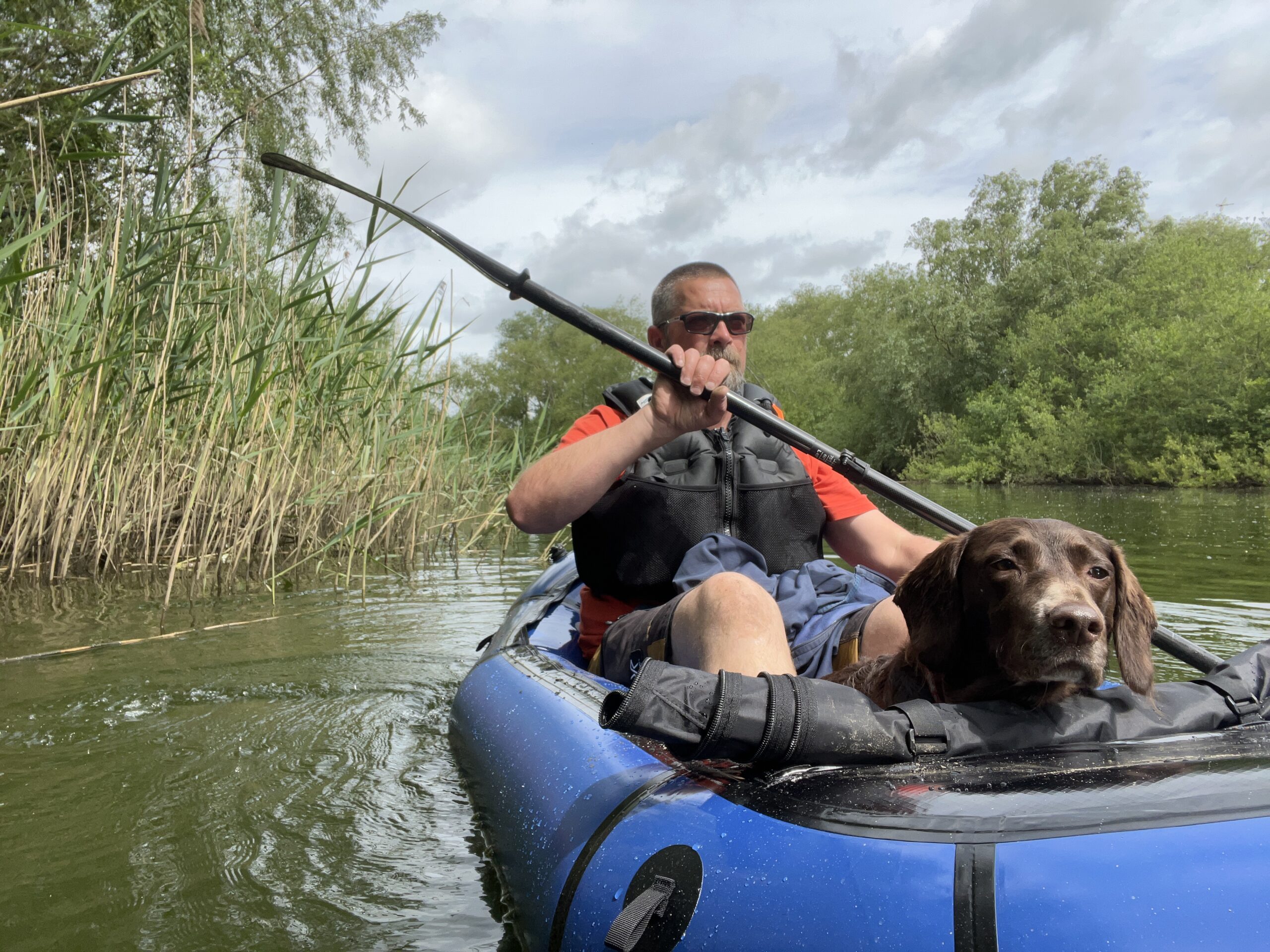
For more information
If you would like to know more please click here Adventure Library
Shop our Sale
Check out our sale! A fantastic opportunity to own your dream packraft & accessories, at a discount!
You Might Also Like
See our other handy guides!
Shop our Sale
Check out our sale! A fantastic opportunity to own your dream packraft & accessories, at a discount!
